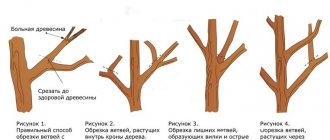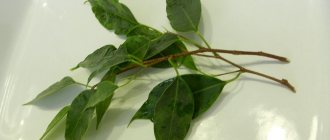The crown of most varieties of ficus without pruning will grow in a chaotic manner, reaching sizes that are not suitable for the room. Timely removal of lateral and apical shoots allows you to make the plant decorative, reduce its length and width, and make it more compact.
Pruning and formation of rubber-bearing ficus is carried out depending on the age of the plant annually or once every 3 years. In addition to formative pruning, you can use the peculiarity of the plant’s shoots to create unique compositions - flexible stems and air layering are tied with a pigtail, a rope, intertwined and directing growth in the opposite direction.
Is it possible to prune the rubber ficus?
Pruning rubber ficus is needed not only to make the tree decorative, but also to improve the health of the plant. It is necessary to remove excess shoots regularly so that it is healthy, lush, leaves and stems have enough space to grow, and all above-ground parts of the bush receive enough light and humidity from the air.
Removal of branches is also carried out for sanitary purposes - diseased, rotten, dry, broken branches draw out nutritional components, taking them away from healthy parts, and can also reduce immunity and cause diseases.
With the help of formative pruning, ficus can be forced to branch or grow compactly. The florist himself determines what crown diameter is suitable for growing in rooms of different sizes.
When pruning, it is recommended to choose branches that are weaker in appearance, thin, with the presence of old bark, cracks and other damage.
How to form the crown of a rubber ficus
Ficus should be trimmed in accordance with the following rules:
- The formation of the crown is carried out during the active development phase from the beginning of spring to the end of summer. If you remove shoots in winter, the plant will be deformed next season.
- If the ficus has recently been transplanted, healthy shoots should not be touched when creating the crown. Sanitary pruning can be done at any time.
- It will be bad if you cut off the apical shoot far from the second bud from the top. In this case, the exposed remaining part of the trunk dies. If you take away the apical shoot along with the buds too late, the ficus will not bloom. It is optimal to remove the apical shoot from the second bud from the top, without leaving “empty” parts of the trunk.
- Be sure to use sharp tools. If the cut is uneven, pathogenic bacteria may enter the tissue. You can take pruning shears, garden shears or a sharp knife. It is advisable to treat all blades with alcohol or other disinfectants before cutting.
- The cut areas on the cutting also need treatment; garden varnish is suitable for this.
You can form a crown in the following way:
- Think about what shape you want to give the entire plant, and also indicate the approximate height and width. Young plants can be pruned annually, and if the ficus has already reached 3-4 years, carry out the procedure no more than once every 3 years.
- Make the cut exactly above the place where the apical bud will be. A fresh shoot grows from it, and if part of the cutting is exposed, the crown will not have a rounded appearance, since the exposed trunk gradually dies.
- Make the cut beveled at an angle of at least 45 degrees on old thick branches, and at an angle of 90 degrees on thin shoots.
- The crown can not only be trimmed, but also thinned. During the procedure, pay attention to the location of the upper kidney. Make sure it faces outward. If you leave the bud horizontally, the branches will grow in width, vertically - in height.
- The classic form for trimming the crown is tiered. The ficus will have the shape of a ball or oval. To do this, the top and bottom of the crown are cut equally, leaving the central branches longer. The lowest branches and the apical shoot are cut off at the root.
- Ficuses also grow in the form of a trunk. To form such a crown, cut off all shoots except five located in the upper part of the trunk. When the plant reaches the desired height, pinch the top bud from the crown, then as it grows, shorten the side trunks, forming a ball.
When growing a bonsai tree, you need to form not only the crown, but also the root system. Roots that are too long are removed during annual replanting, the tops and side shoots are trimmed so that the height of the plant does not exceed 50-70 cm.
When is it required?
It is necessary to trim the crown when it grows strongly. This should be done 1-2 times a year. Plant growth is regulated by pruning. If the branches are not shortened, it will only grow in height. Then, in apartment conditions, the tree will soon become cramped.
Specimens affected by diseases or pests also need this procedure. Rotten or dried areas must be removed. This helps save the ficus from death.
Crown formation is not done all year round. Only a certain period is suitable for this:
- young shoots are pruned in the spring;
- mature trees - in spring or summer;
- In autumn, only diseased branches are pruned.
In winter, ficus hardly grows. If you trim it, the crown will be skewed. New shoots will grow only at the cutting sites.
How to pinch ficus
In order to pinch a plant, you will need pruning shears or a knife, a disinfectant solution (peroxide, alcohol), a soft cloth and a container of water.
Then follow the instructions:
- It is best to perform the procedure in mid-spring. It is during this period that many new shoots are formed, and the wounds on the trunk that appear during pruning heal quickly.
- Once the plant has reached the height you want, you can begin pinching. Disinfect a knife or other tool or heat it over a fire.
- If the top shoot of the tree is thin, you can cut it below the bud by making a straight cut.
- If the length is longer than you need, determine the required height, then find a sheet below that point. Cut the shoot 5 cm above such a leaf, making an oblique cut. The lower level of the cut will be at the level of the kidney on the opposite side. The upper one is directly above the kidney.
- Then moisten a soft cloth and remove the milky juice that appears along the cut.
- After a month, fertilize the plant. It is not recommended to fertilize before this period, since the plant’s immunity is lost after transplantation and it may experience stress.
Pinching will allow the plant to produce new side shoots and stop growing at the height you want. Without this, the tree will hit the ceiling in 4-5 years.
DIY ficus benjamina bonsai
Once you have chosen the right type of bonsai for your pet, start growing it. First of all, you need to choose a suitable container - wide and shallow, always with drainage holes in the bottom. At the bottom you should put a good layer of drainage, a layer of clean river (coarse) sand, and then a layer of nutritious soil suitable for ficuses. Ready-made soil is suitable for Mulberry or Palm.
For a prepared young plant, trim the root system and central shoot at a height of 15 cm. Plant to the level of the root collar, lightly compacting the soil. Water it. Keep the flower in light partial shade for a couple of weeks. Provide good care (Read about caring for your ficus benjamina here ). Maintain the temperature at 25–27 degrees. When the plant takes root and the roots become stronger, begin to gradually prune the branches.
The roots are given the desired shape by repeatedly pruning the main trunk. Regularly pinch out the top bud of the plant. Then the tree will grow wider and not higher. At the same time, the roots will grow.
When the root system and the upper part of the tree grows, transplant the ficus into a larger pot (wide and not deep). Repeat pruning the roots and top branches as you did the first time. With each subsequent transplant, lift the roots a little higher so that they are on the surface of the soil. Ficuses in nature often grow on rocks and rocky soil, clinging to stones with massive roots. You can also place pebbles coated with a mixture of powdered clay and soil under the roots. This technique will allow the ficus roots to stick to the cobblestones, imitating their natural habitat. This creates the effect of roots coming out.
Let us draw your attention to the fact that it will be easier for ficus to stick to rough stones. And further. There is no need to cover the root part of ficuses with soil, moss or pebbles. Just for decoration, you can put colored pebbles or some unusual figures in the pot.
It is advisable to replant no more than once a year, since adaptation takes a lot of time, and frequent replanting can cause the foliage to drop.
This may be interesting: Types and varieties of decorative deciduous Begonias
When the stem reaches the required thickness, stop replanting. Now just trim and shape the crown.
Crown formation
Fast-growing varieties of ficus are cut to two to four leaves after 6 to 8 new ones grow on the shoot. When pruning, milky sap (latex) will appear on the cuts. This is fine. Do not touch it or wipe it with anything. Use clean tools (small scissors, pruning shears or knife). Powder the cut areas with crushed coal or lubricate with garden pitch.
Start pruning from the bottom and gradually move up to the crown. Trim only the necessary shoots, do not touch the leaves, as damaged leaves quickly turn brown and take on an unkempt appearance. Plan major pruning in early spring before the plant begins to grow vigorously. In spring and summer, you can also prune branches, but not so much as to not provoke intensive growth of thin side branches. But in the fall, from October, and in winter, when the ficuses are in the dormant stage, pruning should be stopped altogether.
Shaping the trunk
A stem of the desired shape and length can be obtained in different ways. Let's look at them one by one.
Garter
This method is used when you need to get a curved stem or change the direction of a branch. Tie the top or desired branch to the base of the plant. It will take a lot of time until the ficus gets used to the slope you need and begins to independently maintain the given shape. Then the garter can be removed.
Wire construction
The wire used is special - thin, insulated. Immediately after transplanting and cutting off the branches, this method cannot be used; let the tree get stronger. Only after this can you wrap the stem with wire, starting from the bottom, from the roots, gradually moving up the trunk towards the crown. You cannot pull the trunk and branches too tightly with wire - there is a fear that by doing this you will disrupt the vital processes in the tissues of the tree, and it will begin to dry out. (Or unsightly scars form on the bark).
Having secured the wire in the right places, leave the structure for at least a couple of months so that the tree gets used to the given appearance and learns to maintain it independently. When the time comes to get rid of the wire structure, do not unwind or break it with your hands - you will definitely damage the necessary branches. Only by carefully cutting the wire in all the necessary places will you keep the resulting appearance of your bonsai safe and sound.
Some Special Requirements for Successful Bonsai Growth
- Ficus bonsai are grown in shallow wide flowerpots, in which the soil dries out much faster than in ordinary pots. Therefore, you should pay close attention to watering this little miracle. It will be better if you get into the habit of watering it daily in small portions.
- Daily spraying is also recommended.
- Good lighting is necessary. In winter - up to 12 hours a day, and in summer - up to 16 hours.
- It is almost impossible to grow a beautiful and healthy bonsai without additional feeding. Feed it regularly, starting in spring, with liquid organic and mineral fertilizers a couple of times a month. After transplanting for about a month, no feeding is needed. In winter, one feeding per season is enough.
The video shows the creation of Bonsai from ficus benjamina step by step:
Creating unusual shapes
The formation of the crown of rubber ficus can be done not only in the shape of an oval or ball. There are other pruning methods that can result in trees with unique shapes for indoor design.
Standard tree
Formation of rubber ficus at home in the form of a trunk:
- The standard form can only be created from unformed ficus without lignification on the trunks.
- Side shoots must be removed regularly until 5 top branches remain.
- When the tree reaches the desired height, pinch the apical shoot, not forgetting to remove the lateral shoots.
- While the stems remain flexible and without bark, it is necessary to organize a support. Keep the trunk upright throughout the growing period.
The stamp can be multi-tiered. To form the crown in this way, divide it into 4-5 parts. From the odd ones, make crown tiers, and from the even ones, make spaces between the tiers, for which the shoots are cut 5-7 cm shorter than the rest.
Fence
A hedge from a rubber-bearing variety of ficus can be made as follows:
- select at least 5-7 seedlings and a long, low container for planting;
- place all seedlings in a tray in one row or in a circle, the distance between shoots should be at least 10 cm;
- the fence is formed from the crown - cut at the same height.
Weaving the trunk of ficus benjamina
Spiral
This is the most common type of ficus Benjamin weaving. The reason for the popularity of this method lies in its simplicity and small number of sprouts. Two sprouts are enough, but with three the weaving will look more decorative. Young ficuses should be the same length, about 15 cm. Their trunks should be no more than half lignified. In most cases, a strong support is enough for the flower trunks, around which the stems weave clockwise. The most important thing is to remove side shoots and guide the plant in time. When the spiral of stems reaches the desired height, the support can be removed from the pot, and the flower will delight with its intertwined trunk. In some cases, a spiral can be made from 4 shoots, but with such a trunk there will be more trouble.
This may be interesting: Cordyline - types and varieties for indoor growing
Pigtail
To give the trunk this unusual shape, three or four ficus seedlings of the same length, about 13 cm, and thickness from one to one and a half cm should be planted in one pot at once. This length will already be enough to start braiding. If the thickness of the stems is less than one cm, wait a while with weaving.
First, remove all side branches from the stems, leaving only the tops. Now water the soil in the pot well to make the stems more flexible. If you watered the plant in the evening, you can start weaving in the morning, i.e. The plant should remain watered for at least 10 hours. Then the trunks of young, well-watered ficus trees will easily lend themselves to weaving. But this is not like braiding your granddaughter’s hair before school. You will have to weave this braid for a long time, more than one month, in parts. The first time you will be able to make several turns. But the stems grow slowly, and you will make each next turn as they grow, cutting off the side shoots that appear from them.
The braided part of the trunks must be tied with a soft woolen thread so that they do not unravel. You can adjust the weaving force yourself. If you weave a little looser, gaps will appear between the stems. Insert into them, for example, sticks of the same thickness. Then you will remove these shelves. We assure you that adult ficus specimens will look very decorative. But this will not happen soon. In the meantime, the thread will need to be rewound every month so that it does not grow into the bark. If the weaving was tight, then during rewinding you may see droplets of white milky juice, which indicates damage to the bark. It's okay, the wounds will heal. And yet, make the next harness a little weaker.
The trunks must be tied with threads strictly at an angle of 45 degrees. If your ficus braid is tall enough, we recommend installing a support. Although, usually in this form, with an intertwined stem, the flower holds well in an upright position and does not need support.
Watch the video on how to braid ficus benjamina:
Column (splicing of trunks)
If you want all the stems of your trunks (from 3 to 5 pieces) to grow together into one, you need to carefully remove the bark from the seedlings in small parts at the joints. The trunks should have no side branches, only green tops. Secure the joints with soft thread or wire. Approximately, the trunks will grow together after five to six months. To prevent the thread or wire from growing into the bark, change it every month. The tree will turn out to be very original, with one but unusual trunk.
Lattice
You will need eight seedlings (classic lattice), but sometimes fewer are used if it is not possible to purchase a sufficiently voluminous planting container. The main thing is that their number must be even. Plant your seedlings in one line at the same distance from each other (this is a prerequisite). The sprouts should be the same length and width, not yet lignified. After some time, the seedlings will begin to grow and develop. Wait until the ficus grows to a height of 10 -13 cm and begin to form a green lattice. Take a cardboard pipe and insert it into the middle, thereby crossing all adjacent trunks. Guide them to the desired position using polyethylene or coiled wire. Remember to periodically loosen the clamps to avoid damaging the bark and branches.
The lattice may not be perfectly straight; it may have a curve that will give your design individuality and its own charm.
To better understand the process of weaving ficus benjamina in the form of a lattice, we recommend watching the videos below:
Circular weaving
Circular weaving is done in the same way as lattice weaving, only the sprouts are planted not in one line but in a circle or square. The video clearly shows how to properly plant and intertwine cuttings.
Sometimes circular weaving is created in a different way, using a coconut stem, which is installed in the center of the flowerpot. In this case, seedlings are planted around this trunk at a short distance from it. The side shoots of the sprouts are removed. Considering the fact that the coconut trunk has high humidity, the aerial roots of the ficus will begin to actively develop and intertwine with each other, creating an unusual composition that looks like a vase. If there is no coconut trunk, use a homemade tube made of thick cardboard. To direct the stems and branches in the direction you want, feel free to use a soft thread or insulated thin wire, just do not over-tighten the shoots so as not to damage the ficus. Then both the wire and thread must be carefully removed from the plant.
This may be interesting: How to overcome the difficulties of caring for Poliscias
Caring for the plant after pruning
After pruning, the ficus can be replanted, but the procedure can be performed no earlier than 2 weeks later. An adult plant does not need to be replanted at all; it will be enough to replace the top layer of soil with a new nutrient substrate. If the flower underwent the procedure successfully, after 2 weeks you can begin feeding.
Pruning can be done no earlier than from the beginning of March until the end of summer. When at rest, the plant is not pruned. Monitor the growth of new branches, as well as the height of the ficus, carrying out timely pinching so that it always has a lush, uniform crown.
Ficus is a rather unique flower, because unlike other indoor plants, it only grows upward. Not every gardener will be happy about this fact. Indeed, in this case, you will have to regularly prune in order to give the ficus the necessary shape. However, not everyone can do this task, because only a few know how to trim a ficus.
Why is pruning needed?
With its help you can solve the main problems of growing and care. But not everyone knows how to prune a ficus correctly. After all, using different techniques, you can give it the shape of a bush or trunk, and you can also use weaving of the main trunk, thereby increasing its decorativeness.
At home, this procedure allows you to:
- remove dry and damaged stems;
- reduce the shape and size if the plant has become too large for indoors;
- adjust the shape, giving it fluffiness;
- perform manipulation for the purpose of recovery;
- remove weakened shoots.
- allow the plant to grow more quickly.
If you want to use some special techniques that are quite complex, this work should be entrusted to professionals.
Since it is quite difficult to form a ficus, only a specialist will be able to grow a bonsai from a tree, as well as weave an original composition from the trunk.
Features of the plant
One of the well-known representatives of the mulberry family is the rubber plant, which is usually classified as a member of the genus Ficus. The usual habitats of this plant are India, as well as southern Indonesia and western Africa . In countries with harsher climates, this flower is widely used as an ornamental plant. However, it is valued not only because of its attractiveness, because large varieties of this ficus serve as raw materials for the production of rubber.
Specimens that grow in natural conditions have impressive sizes, which can be up to 40 m in height. Moreover, they often form support roots. The latter are distinguished by the fact that they penetrate deep into the ground, where they take root. More compact is the rubber-bearing ficus, grown at home, since most often it reaches a height of up to 10 m. After routine pruning, this variety begins to look even more miniature.
Beneficial features
Ficus rubber is interesting for many not only because of its decorative properties, because when grown indoors you can maintain a healthy atmosphere . The cleansing effect is provided by the leaves, which filter the air like a pipe. As a result of such filtration, the output is air enriched with oxygen.
Many plant growers are attracted to the rubber ficus by the fact that it does not create problems in care. Instances grown at home do not form flowers, and at the same time they are demanding in terms of growing conditions. The main thing is to make sure that the plant is protected from direct sunlight, as well as to carry out regular watering and periodically give it a warm shower.
Physiology of ficus growth
Ficus rubber can be given any shape. To do this, you just need to trim it correctly. a unique decoration for your home from a seemingly inconspicuous plant . Moreover, even a novice gardener can master this task, but first he will have to familiarize himself with the pruning rules and adhere to them.
The change in the shape of Ficus Benjamin occurs due to new shoots, which usually appear from the buds. Ficus has only two of them:
- apical (located at the very top of the bush);
- lateral, or axillary (located in the axils of the leaves, where the petioles of the leaves are closely adjacent to the trunk).
The apical bud demonstrates the fastest growth, ahead of the lateral buds, which develop very slowly or show no signs of development at all. It is enough to remove the top bud so that the side buds can begin to develop well. Usually the shoots begin to grow in different directions. As a result of such manipulations, the plant begins to change its crown.
How to prune ficus correctly?
Before you start forming the crown, it doesn’t hurt to find out what time of year is best to do this.
Many people believe that it is best to hold this event in the spring , and they will be right. The formation of the crown planned for this time of year makes it possible to give the plant more splendor, since it is in the spring that the best conditions for growth are created for the ficus. Using a similar approach, a gardener can grow a Ficus Benjamina that will be well developed, with fully formed shoots in all directions.
It is not advisable to postpone pruning ficus Benjamin to a later time, for example, autumn or winter, since in this case the shoots will develop within a specific area. This will cause the ficus to look lopsided. It must be taken into account that at this time of year the ficus begins to use the nutrients that it has accumulated in the shoots. As a result of pruning the shoots in the fall, you will leave the Benjamin ficus without these reserves, jeopardizing its survival.
During the formation of the crown, it is necessary not only to change the length of the shoots, but also to adjust the direction of their further growth. For this purpose, special tension devices are usually used.
Does ficus need pruning? When is it needed?
If you want to have an original decoration in the form of an unusual flower at home, then you need to learn how to correctly form the crown of a green pet. New leaves on such a flower appear from the axils on the trunk or on the upper shoots.
After planting it in a new pot, the ficus begins to grow very quickly and stretch upward; if you do not prune it in a timely manner, you may miss the formation of side shoots. All the plant's strength is spent on stretching upward, and it does not have time to send out side shoots. After removing the top bud, additional shoots begin to appear, and a beautiful crown is formed. Pruning is especially important for creating bonsai.
In addition, pruning is important for the normal development of the flower. After removing old branches, new followers form on it faster, and if they are left unattended, this increases the risk of disease.
After pruning, the shoots are formed in different directions, this makes it possible to form the most desired type of crown and give the plant a special appearance.
With indoor plants, as well as with outdoor plants, it is better to carry out all important activities in the spring. It is advisable to prune a flower when it just begins to enter active growth, and this happens in the spring, when it moves away from winter conditions, the arid air of the room and gets used to many hours of sunlight.
At other times, it is undesirable to perform pruning due to the lack of natural light, the plant may develop a one-sided crown. To prevent this, special tension devices are used.
Tools needed for pruning
All materials and tools must be prepared in advance; they must be sharpened. This is a mandatory condition, since bacteria can get into uneven and mashed cuts.
To make pruning easier, you need to prepare:
- gardening scissors,
- pruning shears, which are selected depending on the thickness of the branches,
- knife if you don't have pruners.
Before use, the listed instruments must be treated with alcohol. The cut areas need to be treated with garden varnish.
Crown formation without pruning
There is no need to rush into pruning the rubber ficus. First, it’s worth thinking about whether there is an urgent need for this. There is a simpler way to form a crown, which involves changing direction and securing the necessary shoots. This approach to the formation of the crown allows you to minimize injuries to the plant, which can continue to grow, delighting the owner with a beautiful view. After waiting some time so that the branches can take a new position, the fixing devices are removed.
When pruning, it is necessary to take into account the age of the plant . This operation causes the least harm to young bushes. You need to be more careful with mature plants: since their shoots are not very flexible, shortening them and other similar actions can seriously injure the plant.
Ficus rubber: how to form the crown correctly?
The rules given below are designed for single ficus bushesforming into one trunk.
- It is necessary to prune only those plants whose height is 70 cm. When this moment comes, it is necessary to cut off the top cutting. As a result, the mechanism for the formation of side shoots will be launched. In principle, a cut cutting can be put to good use if it is planted next to the mother plant. This combination will give a new, original shape to the bush.
- Sometimes you have to deal with the formation of the crown of low-growing plants. In this case, you should not prune; you can limit yourself to simply pinching the crown. But it should be borne in mind that after this operation only one sprout will subsequently grow from this point.
- You can also start the process of forming new side shoots by bending the crown. After this, the crown must be fixed in a new position. After waiting for the moment when new shoots begin to form from the upper bud, the trunk is returned to its original position.
- To start the process of forming additional branches, you can do the following: you need to take a thick needle and create a hole in the main trunk with a depth of a third of the thickness. If desired, you can make several punctures, but you need to remember that only from the lowest one will new shoots develop. For this reason, it is recommended to start this operation from the top.
- You can also remove a thin branch by making a straight cut. You need to act somewhat differently in relation to thick shoots, which should be cut at an angle.
- Pruning can only be done with sterile instruments that must have a sharp blade. You can ensure that the instrument is sterilized before the procedure using available means such as fire and medical alcohol.
- After pruning, plant sap often appears from the wound; it must be removed. This can be done using a damp cloth. There is no need to treat the cut site with special preparations.
- A month from the date of pruning, you should start feeding the ficus. You also need to take into account that after this procedure the plant will need a more spacious pot.
In general, pruning ficus rubber is a simple task. The main thing is that you need to strictly follow all the rules of its implementation. So, you need to be very careful with milky juice , which is dangerous for humans due to its toxicity. To avoid undesirable consequences, this work must be carried out wearing protective gloves.
Formation of an unusual crown
If necessary, even a novice plant grower can give the rubber ficus a rather original shape .
- To do this, you will need a pot into which you need to transplant several plants. It is recommended to use young specimens with well-developed stems, the height of which should not exceed 15 cm;
- Be sure to trim off all side shoots. Particular attention must be paid to the trunk, which must be periodically given the required shape;
- It is important not to forget that the branches need to be woven without strong tension to create free space between them, since in the future the trunks will become thicker. You can get a spiral from young ficus plants if you plant them in one common pot. If you want to get a braid, you will need at least three copies;
- You can weave branches only on those plants that have reached the required height - 13-15 cm. Making the next turn may require additional time, since it is done as the ficus develops.
When pruning ficus benjamina or rubber plant, care must be taken to ensure that the braid does not subsequently open up . To do this, it is recommended to garter the trunks using soft threads. It's best if they are woolen. Typically, dressings are performed every two months.
In some cases, for the normal development of the ficus, the installation of a support is required. In this case, you can easily see how spectacular and original the rubber plant will be.
How to trim correctly to give a beautiful shape?
During the pruning process, it is advisable to follow the following recommendations:
- Wash your hands with soap. Disinfect tools with alcohol or heat their metal parts over a fire.
- Carefully examine the plant. You need to plan in advance which branches are best to cut.
- First, dry branches are removed. After this, you can begin to form the desired shape.
- For convenience, the boundaries of removal can be marked with colored tapes or chalk. Then there will be less risk of accidentally cutting off the wrong section of the shoot.
- The cut is made strictly above the kidney.
If it is necessary to trim a small section of the stem, pinch it. The shoots obtained during shearing are not thrown away. This material is useful for propagating ficus.
How to trim so that Benjamin is fluffy and lush?
The crown will be thick if you do the following:
- shorten the trunk by 5-10 cm;
- periodically trim the remaining shoots to activate the lateral buds;
- Prune both outer and inner branches.
After this, the plant almost does not grow upward. It begins to actively grow in breadth. Removing the top of the trunk can only be done once a year. The lateral processes are trimmed 2-3 times a year, but no more.
Attention! When trimming side stems, the direction of growth of the bud next to which the cut is made must be taken into account. The shoot will grow in the same direction.
What should I trim to make the plant bush?
In order for the ficus to take on the shape of a bush, you must:
- Trim off the top of the central stem. If the height of the tree is less than 80 cm, the top is shortened by 10-15 cm. With a height of 1 m, you can cut it to 20-25 cm.
- Shorten side shoots that have reached a length of 10-12 cm by 2-3 cm.
- As they grow back, cut off the side shoots again.
After deep pruning of the trunk, the plant gradually takes on the desired shape. And if there is high humidity in the room, the ficus grows aerial roots. They can be directed into the soil. Then they will gradually take root and form a banyan tree with a spreading crown.
General information about the rubber plant and the need for pruning
Ficus rubber is native to the tropical forests of India and Indonesia. Belongs to the Tutov family. In its natural habitat, it is an evergreen tree reaching 40 m in height. The leaves of the tree are oval, elongated, with pointed ends. The surface of the leaves is shiny, covered with skin, the color is rich green. The leaves grow up to 30 cm in length and are attached to the trunk with a long petiole.
At the site of leaf attachment, small round green fruits are formed. Young leaves are brown with a pinkish tint, and as they age they become dark green. This type of ficus is known for the fact that rubber is extracted from it, which is used in construction and industry. In India, wood is used to create hanging bridges.
The most famous ornamental varieties include Decora, whose young leaves have a bronze tint, and Doescheri - with variegated leaves.
Caring for ficus Microcarpa Ginseng at home
Ficus microcarpa ginseng belongs to the Mulberry family. In its natural environment, the plant reaches a height of 25 m. At home, the flower is dwarf and grows in the form of a bonsai tree.
With its thickened trunk, similar to a large root, the wild plant resembles ginseng. When growing ficus at home, creating such a root system is problematic, but possible.
Home care
Growing ficus Microcarpa Ginseng is a painstaking process. Proper care is to ensure conditions favorable for plant growth:
- optimal microclimate;
- high-quality timely watering;
- competent feeding.
If the leaves of a ficus turn yellow and fall off immediately after moving to a new home, this is a normal reaction of the plant. It is due to the acclimatization and adaptation of the plant to new conditions. A healthy ficus will recover on its own in a few weeks.
Watering and humidity
Watering should only be done when the top layer of soil is slightly dry. Excessive moisture can cause stagnation of water, during which the roots of the plant will gradually begin to rot. In summer it is necessary to water the plant often and abundantly, in winter - as needed.
Cold water is harmful to the plant. Before watering, it should be warmed to room temperature, otherwise the leaves will fall off the flower.
The air humidity in the room where Ginseng grows should be high. It is recommended to spray the ficus leaves (not the trunk) once a day.
Experienced gardeners use a warm shower. It helps the plant rejuvenate. This procedure can be carried out no more than once a month. From time to time it is advisable to wipe the ficus leaves with a damp cloth.
Feeding and replanting
With the onset of the active period of plant development (from spring to autumn), it must be regularly fed with substrate.
Once every 14 days, a nutrient mixture should be added to the soil, since high-quality fertilizing is essential for active growth.
Gardeners experienced in growing ficus Ginsenga recommend alternating mineral fertilizers with organic ones and applying them before watering.
Timely replanting is another necessary procedure to ensure proper care of the plant at home. It is advisable to replant young ficuses once a year, and adults - once every few years. Replanting must be done very carefully so as not to damage the roots. If they are touched, the plant will shed its leaves.
To renew the soil, you can purchase a ready-made mixture or make it yourself. To do this, you will need to mix sand, picking soil and clay granules in equal proportions.
Reproduction
Reproduction of ficus Ginseng occurs:
- 1 Cuttings. At the beginning of spring, cuttings with several leaves are cut from the tops. The shoots are placed in water for several hours, which is changed periodically. Then the cuttings are moved into a pre-prepared substrate and covered with film. The container with the cuttings is moved to a well-lit, warm room. Care at this stage comes down to ventilation of the greenhouse and infrequent watering. After a few months, the cuttings take root and are planted in pots.
- 2Root cuttings. A part of the root of an adult ficus is cut off and placed in water for 2–3 hours. Then it is planted in a mixture of peat and sand and covered with film. As soon as the first leaves begin to appear, the film is removed. After a few days, the young ficus is transplanted into a container.
- 3Air layering. A small cut is made around the bark of the plant, and damp moss is placed on top of it. Everything is wrapped in film. The greenhouse is periodically ventilated. When roots appear, the top is cut off and the ficus is transplanted into a pot. They rarely resort to this method of reproduction.
Rules for pruning that is safe for the plant
First of all, in order for pruning to bring maximum benefit and not harm the flower, you must use a sharp, disinfected knife or pruning shears; scissors are suitable for thin branches. To peel off, you need to retreat 10-15 cm from the top, that is, approximately 3-4 leaves.
In addition, experts recommend using gloves and glasses when pruning ficus, since the milky sap contains toxins that can trigger the development of an allergic reaction. Pruning is best done in the spring, when the plant begins its active growth phase. It is during this period that you can get the maximum result.
Experienced gardeners recommend carrying out manipulations when the height of the flower reaches 70 cm. It must be remembered that removing most of the stem can lead to the plant stopping growing and remaining the same size.
Step-by-step guide to forming a plant
By pruning the top or side branches of an indoor ficus, over time you can get different shapes and sizes of the tree. It is better to start forming a plant at a young age, when it is still quite flexible and can be easily directed in any direction.
Forming a plant will allow you to follow several rules:
- garden scissors (secateurs) must be well sharpened and disinfected;
- The branches should be cut slightly above the buds: thin ones at a right angle, thick ones at an angle of 45°;
- The branches need to be cut above the bud facing the direction of the room;
- it is necessary to completely remove branches inside the bush, as they lead to thickening;
- After trimming, you should blot the sections with a cloth and treat them with crushed activated carbon.
Did you know? The root system of rubber-bearing ficus trees is so strong that in some Indian regions it has been used for many centuries to build “living bridges.” To do this, bamboo poles are thrown across a ditch or river, which serve as guides for the roots of the tree. The plant needs about 10 years to “construct” a 30-meter bridge, and more than 50 people can be on it at the same time.
Bush shaped
To grow an indoor ficus in the form of a bush, you should begin to form the plant at a young age, cutting off all young branches when they reach a length of 10–15 cm. This activates the growth of axillary buds, from where young branches will begin to sprout intensively. When they reach a length of 8–10 cm, their tips also need to be trimmed. Thus, by pinching the growth points, the ficus will not grow long, but will gain volume and turn into a nice bush.
Video: Trimming and pinching ficus
Since the ficus is light-loving, the pot with it must be periodically turned in different directions towards the light source. This way the plant will develop more evenly.
In the form of a standard
In order for the plant to form in the form of a trunk, you should adhere to the following technology:
- Remove all side shoots, leaving five apical buds to form five supporting branches of the crown.
For a tree that is on the floor, cut the central trunk at a height of 100 cm from the floor. If it is on a table or stand - at a height of 40–50 cm from the ground level.
- For support, install a peg or lattice in the pot, tying branches to it as it grows. When the plant grows, the support can be removed.
- Pin off the five remaining top shoots when they grow to a height of 4–6 buds. Trim above the top bud facing the room.
- Next, the density of the bush is formed in the same way - by pinching the length of the branch. This stimulates the growth of side shoots on it.
- When the required crown volume is formed, trim overgrown shoots from time to time.
Wicker ficus
Let's look at ficus weaving using the example of several identical ficus Benjamin seedlings with a trunk thickness of 1–1.5 cm:
- Plant young trees next to each other in one container.
- Remove all side branches, leaving only the tops.
- About 12 hours before starting the weaving process, water the ficus plants well to give them greater flexibility.
- As the trunks grow, begin braiding the braid, not forgetting to tie the braided part of the plant.
- The strength of weaving can be chosen at your discretion. You can get equal gaps between the trunks by inserting pencils into them. In order for the stems to grow together, carefully remove the bark at the junctions in small sections.
Video: Braiding ficus
Methods for forming the crown of rubber ficus
Ficus can be given different shapes. Its choice depends on aesthetic preferences, as well as the size of the tree.
Stamb
The stem of the plant is exposed in the lower part from excess leaves and young shoots. If the pot with a flower is on the window, about 40 cm are exposed, and if on the floor - 90 cm. In the upper part of the flower, 10 cm is cut off. Thanks to this, upward growth is stopped, accelerating the lateral one.
Stamb
Having chosen the required height, the lateral branches from the side of the outer bud are pinched so that growth occurs parallel to the stem and the ficus branches to the sides. In this way, a standard type of crown is obtained.
The bush shape of the crown can be formed in several ways. In the first method, the flower is allowed to grow to 80 cm, after which 10-15 cm of the top are cut off. Side shoots need to be pinched if they have reached 10 cm. Pruning the stem helps to activate the growth of the side part, due to which the side part grows intensively, forming a voluminous crown.
When using the second method, the plant is provided with constant high humidity. As a result, aerial roots are formed on the stem, which are directed into the substrate. Once the roots sprout and take root, they take on the shape of a banyan tree. Regularly trim excess roots and branches.
Spiral
The entwined stem is firmly tied to the support. At the same time, side branches and shoots are constantly trimmed so that they do not stick out.
The spit shape is formed when the plant is still young. The dimensions should not exceed 15-18 cm. To do this, you need to plant 3 young shoots in one pot and wait until each of them grows to a height of 18 cm.
Types of shaping and trimming
In order to form a beautiful and neat ficus bush, pruning should be done as early as possible. The entire process of ficus formation can consist of the following stages:
- Trim the main shoot of the ficus at a height of 10-20 centimeters. If the ficus has large and large leaves, then there should be at least 5-6 of them left.
- If the side shoots of the ficus have reached a length of more than 10 centimeters, then they must also be pinched. The cut is made above the bud, which faces outward.
- All newly made cuts must be sprinkled with crushed coal, but before doing this, remove the released milky juice.
- If the ficus bush has a large density of shoots, then some of them must be removed, especially those that are located inside the crown and thicken it.
For uniform growth of shoots, the ficus must be periodically turned to the sun in different directions.
Stamb
You can form a ficus not in the form of a bush, but in the form of a trunk. To do this, you need to choose a young plant that has a pronounced central trunk. The process of ficus formation boils down to the following:
- On the main trunk of the ficus, all side shoots must be trimmed regularly. Leave only a few located at the very top of the trunk.
- When the ficus reaches the desired height, usually 30-40 centimeters if it is located on a table or windowsill and about 60-100 centimeters if grown on the floor, then stop pruning the side shoots.
- After this, you need to pinch the top of the ficus, this will give a good incentive to the development of side shoots of the ficus.
- If the side branches are very elongated, then they must be cut off above the bud, which looks outward.
To give the trunk stability, you can tie it to a peg, which can then be removed. All cuts that are made must also be wiped with a damp cloth and sprinkled with crushed coal.
Tiered standard
You can form a trunk in the form of a tier, but for this you will need an already mature plant that has a pronounced central trunk.
The process can then be represented in the following steps:
- As soon as the ficus reaches the desired height, it needs to be cut off at the top.
- If it is planned to form a two-level trunk, then the ficus crown must be divided into three parts: the 1st and 3rd are located on top, these are the levels that will be spherical, and the 2nd part is between the levels, it is freed from all shoots.
- If it is intended to form 3 levels, then the crown must be divided into five parts. 1,3 and 5 are the upper future levels, which are given the shape of a ball, and 2 and 4 are the distance between them, freed from all shoots.
- You can form the levels from top to bottom, but then the top of the stem cannot be removed until the ficus grows to the desired height.
All care for such a multi-tiered ficus will boil down to cutting off all the overgrown shoots on the bare part of the trunk and removing some young shoots that grow inside the crown and thicken it.
From some ficus trees that have small leaves, for example, Ficus benjamina, you can, if desired, form real green figures in the form of a ball, pyramids, cubes, in the shape of animals and birds.
Arc
- When the plant reaches sufficient height, cut off the top.
- Now you need to bend the plant and secure it, being careful not to break it. In this position, the shoots begin to grow upward.
- When the required shape is acquired, the fixation can be removed.
Spiral
We'll need one escape. Weaving is carried out as follows:
- We plant the cuttings in a pot.
- Depending on the width of the required turns, we select the diameter of the support, which we will install next to the handle. A bamboo stalk or some kind of tube may work for this.
- At a height of 15 cm, the stem is wound onto a support. To obtain uniform turns, inserts are used for a short time. We leave the inserts for a short time so that they do not begin to grow into the stem.
- As soon as the tree reaches the required height, the support is removed.
The spiral looks unusual and decorative.
Scythe
For a braid, you need to braid several plants at a distance of 5-10 cm from each other , or you can use one tree with 3-4 side shoots. Work on the desired shape begins when the tree reaches a height of 15 cm:
- If there is one plant, then it is necessary to change the direction of growth of the outer parts of the braid from the central one in opposite directions, tying them to a branch. If there are several plants, then this action is omitted.
- We take the right shoot and throw it over the middle one at an angle of 45 degrees.
- We secure it in this position using threads.
- We wait until the plants stretch out.
- We cross the resulting center with the left shoot.
- As we grow, we repeat the steps.
Make sure that the loops are the same.
Fence
For the fence, trimmed plants are used. The shoots are planted in a box in one row. In young plants, the top layer of bark is cut off, the juice is wiped off and the stems are connected by tying them. The trees will begin to grow together, the more light there is, the faster they will grow together.
Forming a crown without cutting leaves
The desired shape can be formed without trimming. In order to weaken the growth of the bud, it is necessary to make a vertical deep incision above it and remove the bark around the incision. This method is called kerbovka. You can also use plant hormones (cytokines), which affect the acceleration of lateral growth.
It is best for young plants to form a crown without pruning, as they are flexible and will not break, unlike mature ones. To create a uniform crown, it is recommended to periodically rotate the tree in relation to the light.
Care after pruning
There are a number of rules that must be followed in order for the flower formation process to be successful:
- When cutting, stumps should not be left, as they become hotbeds for the development of fungal and bacterial diseases.
- After pruning, a milky sap begins to ooze from the plant, which must be immediately wiped off and the cut area sprinkled with crushed charcoal or any fungicide.
- You can fertilize the ficus after pruning once a month.
Ficus pruning process
- In addition, after pruning, it is necessary to regularly wipe the leaves from dust in order to reduce the risk of infection of the plant.
- A month after the procedure, when the cut sites have completely healed and the side parts begin to actively grow, the flower can be replanted, and the top layer of the substrate can be changed for mature plants. Experts recommend using the transshipment method in order to minimize the risk of injury to the root system during transplantation.











